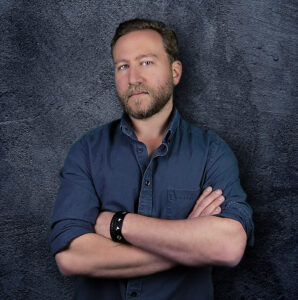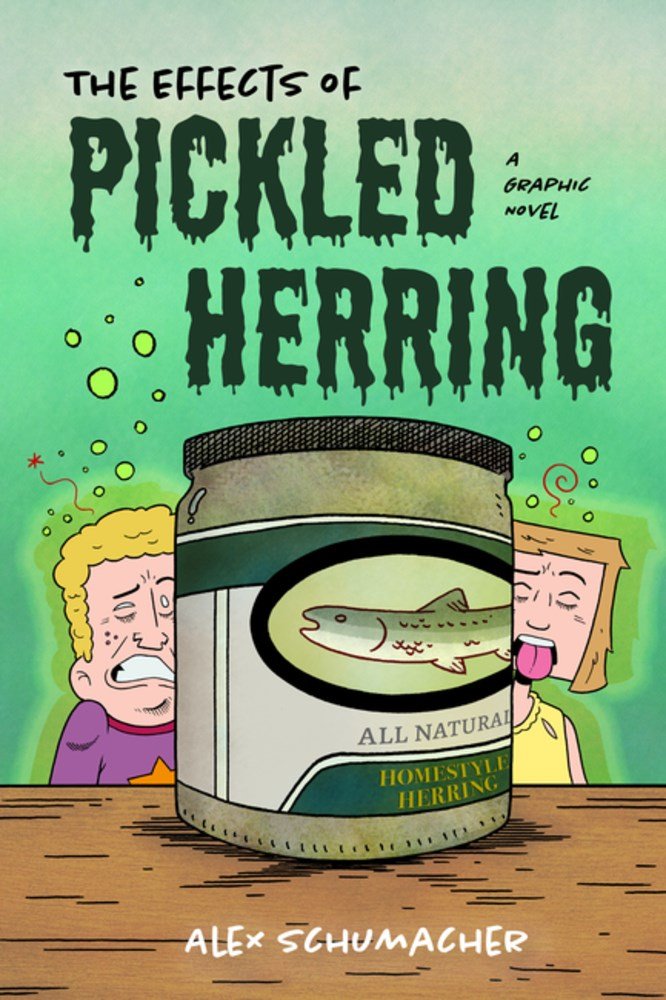Alex Schumacher’s graphic novel THE EFFECTS OF PICKLED HERRING (Mango Publishing Group, 2024), follows Micah Gadsky, who is balancing a lot in his personal life as he prepares to become a Bar Mitzvah. In addition to troubles at school and questions about faith, Micah’s world is impacted by his grandmother’s Alzheimer’s disease. Inspired by experiences in Alex’s own life and family, THE EFFECTS OF PICKLED HERRING is meaningful and thought-provoking. I am thrilled to learn more about Alex’s process of writing and illustrating this graphic novel. Welcome, Alex!
THE EFFECTS OF PICKLED HERRING touches on some serious topics, such as Micah’s and Alana’s grandmother’s Alzheimer’s and antisemitic bullying. How do you balance these topics with humor?
Humor has been a device of self-preservation for the Jewish people since time immemorial. At least that’s what Mel Brooks taught me. I don’t know if it’s an inherited trait per se, but balancing the atrocious with the amusing has always felt natural. Maybe that’s odd. Maybe that’s a cultural thing, but either way I’ve come to find that keeping and guarding the ability to laugh in the presence of the big bad—or big bads—can remove some of its/their power.
I think this is an especially important message when presenting the heavier issues to younger audiences. It was important for me to include those lighter moments. A prat fall or a spit take after every piece of unfortunate news isn’t really necessary either. Readers just need enough time to process the information you’ve given them, and some intermittent comedic relief grants them the opportunity to step out, take a breath, maybe have a giggle, and then proceed. A lot of it comes down to finding the right moments to insert humor where it continues the momentum and provides some levity without making a joke of the bigger issue.

Micah and Alana have a special sibling bond, but as they head into their Bar/Bat Mitzvah, they approach life very differently. How did you create and develop their characters?
To varying degrees, characters in my books tend to be inspired by people in my life. One character might be an amalgam of several people. Another might be molded around one single endearing quirk. As for Micah and Alana, their shared arc is based almost explicitly on how I felt about my sister during that time in our lives. Which is to say guided by some false narratives and not fact. The outline was essentially me jotting down the events that led up to our b’nai mitzvah in order to the best of my ability. Then I needed to build these highly fictionalized versions of those events if for no other reason than the world has changed dramatically since I was twelve.
So, it wasn’t surprising that as I wrote these characters based on my sister and me into a story similar to our own, but existing in a vastly different era, they started to develop their own idiosyncrasies and traits. One example is Micah can be a bit more neurotic and easily overwhelmed than me. And that’s saying something, let me tell you! Brian Eno once said about creativity, “Think like a gardener, not an architect: design beginnings, not endings.” With that in mind, I could plant seeds but had to give the Gadsky siblings room. Room to sprout. Room to grow. Room to branch off. And room to form their own unique connection based largely on this maelstrom of wild mishpucha, evolving identities and relationships, and charging towards adolescence in an increasingly uncertain age.
In your author’s note, you mention that some aspects of THE EFFECTS OF PICKLED HERRING were inspired by your own life, especially your grandparents. How did this impact the creation of the novel?
It’s honestly the most I’ve shared of my own life in any project to date. It’s also my longest work to date so going in with a strong sense of the world that the characters were inhabiting was a huge boon and a direct result of liberally mining the people and places I love for inspiration. From a bit of a self-serving standpoint, it’s a way for me to immortalize those personal associations to some degree. Specifically with my grandmother, it was an opportunity to honor her by raising some Alzheimer’s awareness. The disease presented an intriguing counterpoint to Micah’s other daily goings-on too. Since it was never intended to be a memoir though, I figured I was free to take plenty of creative liberties… and I 100% did just that! The character designs are basically funhouse mirror versions of their real-life counterparts, at best, and did my utmost to present their personalities similarly. Because of this combination the book ended up straddling the line between real and surreal in a way I had never attempted before but rather enjoyed. Lots of firsts with this book!
As an illustrator and author, what comes first to you – the text or the art?
The simple answer is text. I’ll often start having specific ideas of the direction in which I’d like the art to go fairly early in the writing process, but I have to lay out at least some of the story first. This type of question reminds me of an interview with Art Spiegelman where he refers to himself as “a writer that draws,” since I feel similarly towards my own skills. This isn’t to sound pretentious or obscure the fact that I’m a cartoonist, but to emphasize the notion that I simply am more comfortable with writing than with drawing. And don’t get me wrong… I love drawing! I’m also a realist when it comes to my level of ability. In the ten years that I’ve been seriously scribbling, shapes of sentences have just always translated better on the page for me than shapes of illustrations. All that said, we artists aren’t exactly known for being the best judges of our own work.

For non-artists, can you share a bit about your illustration process – from sketches to completed projects?
I’d be happy to! While I have a terrible habit of skipping the “model sheet” portion of character design, where you develop how everyone looks from the front, side, back, etc., I do go to great lengths to distinguish each individual’s look, style, personality, etc., based heavily on the silhouette test. This is a principle used most notably with animation where the artists ensure the audience can still identify a character from only a black outline. Truth be told, I do have a tendency to rush through this phase as 1. I have zero formal training and 2. I’m too eager to jump directly into the storytelling. In this capacity I’m more of a “do as I say, not as I do” artists since it is actually an integral part of the process.
I’ll add here that I still work traditionally on paper, so my method varies a bit from those who create digitally. Once I have a functional design, the artwork moves through a few different steps: Thumbnails, pencils, and finally inks. “Thumbnails” are the fancy term for small, tremendously rough versions of a page to give editors an idea of how panels will be arranged and where players will be positioned in each panel. From there I lay down composition lines with non-photo blue pencils (these will not reproduce when scanned) and ink directly on the approved pencils with a variety of tools—mainly Sakura Micron and Faber-Castell pens with some brushes every now and again.
In many ways, this book feels like a love letter to your family – especially your grandmother. What do you think she would have thought about the book?
Oh, she would have loved it. She would have been incredibly proud. I say that because she was the type of grandmother who was proud of all of her grandchildren’s accomplishments, both great and small. She was playful, genuine, and caring, which I hope comes through in the book. Empathy and understanding were woven into every lesson she ever taught me and my siblings. Grams was a social worker and devoted herself to the pursuit of improving other’s lives. Socially, she and my grandfather were movers and shakers at our synagogue. Considering my grandmother’s love for our culture, I think she’d approve on the grounds that this could possibly give our community a bissel more visibility in the publishing and comics industries. She’d honestly be on board with anything that made others feel seen and less alone in this world.
What do you hope readers take away from THE EFFECTS OF PICKLED HERRING?
That they are loved, and that they belong in a world that can sometimes feel neither loving nor welcoming. We all have anxiety. We all have self-doubts. We all use forms of escapism from time to time. We’ve all needed to adjust to a new normal. We’ve all needed reassurance. Some of us have bar and bat mitzvahs. Some of us have grandparents who are living with one ailment or another. Life can feel overwhelming and isolating at any age, which is precisely why stories, and access to stories that discuss difficult issues are so important.
Thank you, Alex!
ALEX SCHUMACHER is an author/illustrator whose work has appeared in the form of picture books, comic strips, graphic novels, and too many paper napkins to count. From an early age, his cartoons were regularly displayed in a number of respectable kitchens by adoring relatives. Alex has also written for periodicals and websites such as Comicon.com, The Comic Book Yeti, and Monkeys Fighting Robots Magazine. While often lost in his imagination, he can mostly be found in San Francisco where he lives with his wonderful wife and beloved—but incredibly clingy—dog, Meldrick. Visit him online at https://alexschumacherart.com/.